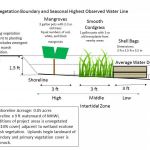University of Central Florida's Living Shoreline Project
Description
We began experimenting with living shoreline stabilization techniques in 2009 to decrease erosion on shorelines along major boating channels and increase availability of intertidal habitat. After identifying optimal methods for our study site in Mosquito Lagoon in Canaveral National Seashore, we installed our first living shoreline to protect the shell midden known as Turtle Mound in 2011. We continued to refine our methods and identify site-specific factors impacting our success and have created living shorelines at nine additional sites to date, for a total of 1160 m of shoreline stabilized using a combination of native vegetation and oyster substrate. Currently, we have projects in St. Johns, Volusia, and Brevard Counties along the east coast of Florida. All projects were completed with the help of thousands of volunteers and support from local communities in five Florida counties. On-going monitoring is allowing us to continue to evaluate the effectiveness of our restoration long-term and develop alternative methods to address site specific issues.
Technical Details
This project included the construction of fringe oyster reefs utilizing 3 ft long oyster shell bags, stacked two bags high and placed perpendicular to the shoreline in the lower intertidal zone. Landward of the oyster shell bags, we planted smooth cordgrass and mangroves in a 6 foot wide area below MHW.
Funding
We have received funding and support from the National Park Service, Florida State Parks, U.S. Fish and Wildlife Service, Florida Fish and Wildlife Conservation Commission, Coastal Conservation Association, Indian River Lagoon National Estuary Program, St. Johns River Water Management District, Marine Discovery Center, Brevard Zoo, Guana Tolomato Matanzas Research Reserve
Contact
- Melinda Donnelly
- This email address is being protected from spambots. You need JavaScript enabled to view it.
